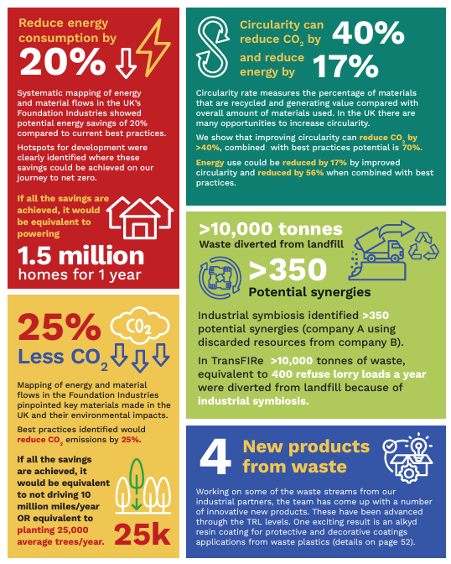Industrial Symbiosis – The Journey So Far
Christopher Pilgrim, Technical Lead for the Transforming Foundation Industries Challenge at Innovate UK Business Connect offers a special insight into the concept of industrial symbiosis, and how it can be carried out in multiple ways across different countries.

Believe it or not, waste from one industry can be an important raw material for another: take Ground Granulated Blast-furnace Slag (GGBS). GGBS starts off as a mere by-product of steel manufacturing with little-to-no value. Upon closer examination, however, it actually serves as a useful building block for manufacturing concrete. Through such synergies between different industries, greater value can be derived from materials used, leading to a more efficient system overall. This relatively simple premise is a key part of industrial symbiosis but the full concept goes deeper than that.
True industrial symbiosis relies on collaboration between businesses to share and exchange resources to save money and minimise waste. These underutilised resources could include materials such as those mentioned above, but also heat, water, industrial capacity and expertise too. It’s like asking your neighbour to borrow a screwdriver or asking your electrician friend for advice on your electrics, except on an industrial scale. At its heart, industrial symbiosis relies on having a network of localised, trusted relationships.
Fundamental to UKRI’s Transforming Foundation Industries (TFI) Challenge, delivered by Innovate UK, the Engineering & Physical Sciences Research Council (EPSRC) and the Economic & Social Research Council (ESRC), has been helping to create and develop such a network. While there have been examples of industrial symbiosis across these industries, the potential to save money, resources and emissions through deeper collaboration is huge. This is crucial for the UK, as our foundation industries (cement, metals, glass, paper, ceramics and chemicals) produce roughly 50 million tonnes of CO2 per year, equivalent to 10% of all CO2 emitted by UK homes and businesses.
What are the conditions needed for industrial symbiosis?
Understandably, proximity is an important factor to support industrial symbiosis. Many synergies are not practical or economically viable over long distances, as the cost and energy required to transport a given resource may offset any potential saving. This is why local clusters are an important driver for industrial symbiosis.
But the collaborative culture needed for industrial symbiosis to thrive needs to be fostered. It can be difficult to identify potential synergies but it is even more difficult to develop this into a working relationship. Many barriers can stand in the way: costs, logistics, quality and consistency but also perhaps most importantly, trust.
The Kalundborg Symbiosis
One prominent example of industrial symbiosis in action is the Kalundborg symbiosis in Denmark, established in 1972. What started as a Danish industrial park in the 1950s with the opening of the Asnæs Power Station led to a thriving partnership of 16 public and private companies adopting a circular approach to production at a thriving eco-industrial cluster.
The Asnæs Power Station opened in 1959 and eventually provided the city of Kalundborg with a district heating network stemming from waste heat generated within the power plant. The industrial symbiosis properly began in 1972, and by 1979, the Power Station started to supply waste products of use to cement manufacturers in Northern Denmark.
In 1990, Statoil, a Norwegian state-owned energy company, which also owns Denmark’s largest oil refinery, completed work on a sulphur recovery plant based within the Kalundborg industrial park. This new facility was able to recover waste sulphur produced by the park and sell it on as a raw material to a sulphuric acid manufacturer located in Southern Denmark.
The Kalundborg symbiosis started life as a means for companies to gain competitive advantage over rivals. However, over time, this business industrial park has become not solely focused on industry and competitive gain itself, but also in creating more sustainable practices.
Industrial Symbiosis in the UK
The UK has adopted industrial symbiosis in its own unique way. In 2003, the UK National Industrial Symbiosis Programme (NISP) was established as a business-led plan to become an independent facilitator of industrial waste between three clusters: the West Midlands, Scotland and Yorkshire & Humber. In 2005, the NISP expanded to become a national programme with support from the Department for Environment, Food and Rural Affairs (DEFRA).
Between 2005-07, NISP managed to save 5.4 million tonnes of virgin raw materials and diverted 2.5 million tonnes of waste from going to landfill. While the NISP programme no longer exists, regional industrial symbiosis activities have been getting underway over recent years, including in the UK’s key industrial clusters. The TransFIRe project, for example, has connected academic expertise with industry experts in this area to help raise awareness, identify opportunities and strengthen capabilities. A outline of the achievements through this project are given in the extract from the final report below.
Alongside this, the TFI Challenge has funded several important collaborative projects to test new potential synergies and build new networks.

From Ashes to Glass with EnviroAsh
For example, the EnviroAsh project has found ways of converting waste materials from a number of foundation industries, especially biomass bottom ash from Ely Powerplant and slate tailings from Honister Slate. These materials were obtained by Glass Technology Services to manufacture new glass products, including containers, as well as fibre glass, windows and drinking containers.
By managing to add up to 10% additions of ash materials into green and amber glasses, plus a small addition to flint glass, the project found there could be a 2-5% energy saving from using ash material, as well as a CO2 saving of 3-10% from this production method.
South Wales with Both Eyes Open
The South Wales with Both Eyes Open project has enabled greater collaboration in the industrial heartlands of South Wales between industries vital to the economic future of the region.
At the moment, southern Welsh businesses spend vast sums having to store industrial waste or send it to be processed abroad. The South Wales with Both Eyes Open project discovered that, simply by recycling or reusing some of these waste materials, businesses in the region could save up to £50 million per year.
This includes putting waste materials containing valuable metals such as zinc to good use through extracting the metals from the waste. Other waste materials these businesses generate can even be explored as possible sources of energy to be used as feedstock by other businesses. Conclusions made from the project ultimately informed the plans for the South Wales Industrial Cluster.
What next?
Successful international examples show that sustained support is necessary for industrial symbiosis to develop and take root. In more recent years, a network has started to develop through the TFI Challenge and other initiatives but efforts need to continue to encourage a broader, more collaborative culture. There are different ways this can work in practice but I hope to see support continue, to realise the full potential of industrial symbiosis.
Don’t just read my opinion, listen to the experts – listen to the podcast on the topic with Dr Anne Velenturf, a leading voice on this topic, and Chris Holcroft, who led the EnviroAsh project.
Author: Christopher Pilgrim, Technical Lead for the Transforming Foundation Industries Challenge
Related content

Foundation Industries
Situated in our industrial heartlands, these sectors include metals, ceramics, glass, chemicals, paper and cement, producing 28m tonnes of material per year, and are worth £52bn annually to the UK economy.

